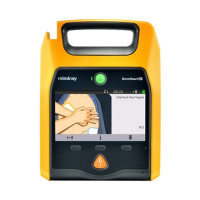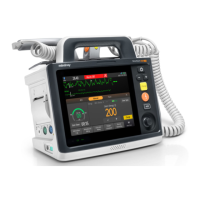Defibrillator/Monitor Operator’s Manual 5 - 11
5.7.6 Automatic Arrhythmia Relearn
Arrhythmia relearning is initiated automatically whenever:
■ The ECG lead or lead label is changed
■ The ECG lead is re-connected
■ Patient category is changed
■ The paced status is changed
■ Arrhythmia analysis is switched on
■ [Stop Calibrating] is selected after ECG calibration is completed.
5.8 Calibrating ECG
The ECG signal may be inaccurate due to hardware or software problems. As a result, the ECG wave amplitude
becomes greater or smaller. In that case, you can perform ECG calibration to check if the ECG wave amplitude is
in normal range.
1. Rotate the Navigation knob to move the cursor on the ECG filter mode.
2. Press the Navigation knob to highlight it.
3. Rotate the Navigation knob until you find [Diagnostic], and then press the Navigation knob to confirm the
selection.
4. Select the ECG parameter area to enter the [ECG Setup] menu.
5. Select [Others >>] → [Calibrate]. In this case, a square wave appears on the screen and the message
“Calibrating ECG” is displayed.
6. Compare the amplitude of the square wave with the 1mV wave scale. The difference should be within 5%.
7. After the calibration is completed, select [Stop Calibrating].
You can print out the waveform and wave scale and then measure the difference between them if necessary. If
the difference exceeds 5%, contact your service personnel.
5.9 ECG Troubleshooting
This section lists the problems that might occur. If you encounter problems when using the equipment or
accessories, check the table below before requesting for services. If the problem persists after you have taken
corrective actions, contact your service personnel.
• For the physiological and technical alarm messages, refer to EAlarm Messages.
Problem Corrective Actions
Noisy ECG traces 1. Check that electrodes are not detached or dry. Replace with fresh and
moist electrodes if necessary.
2. Check that leadwires are not defective. Replace leadwires if necessary.
3. Check that patient cable or leadwires are routed too close to other
electrical devices. Move the patient cable or leadwires away from
electrical devices.
Excessive electrosurgical Interference Use ESU-proof ECG cables. For details, refer to 28.1ECG Accessories.
Muscle Noise Inadequate skin preparation, tremors, tense subject, and/or poor electrode
placement.
1. Perform skin preparation again and re-place the electrodes. For details,
refer to 5.4Preparing for ECG Monitoring and Measurement.
2. Apply fresh, moist electrodes. Avoid muscular areas.

